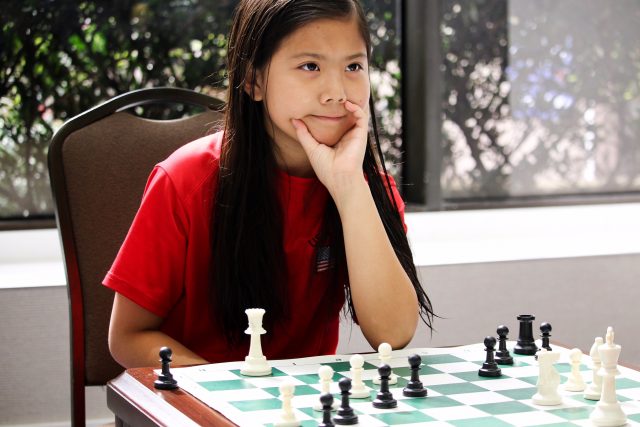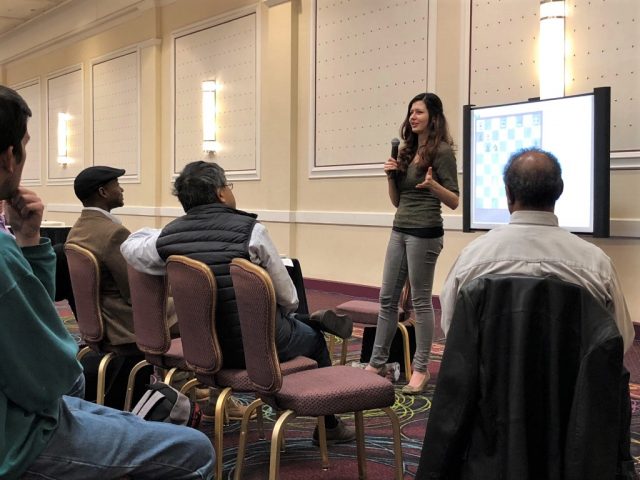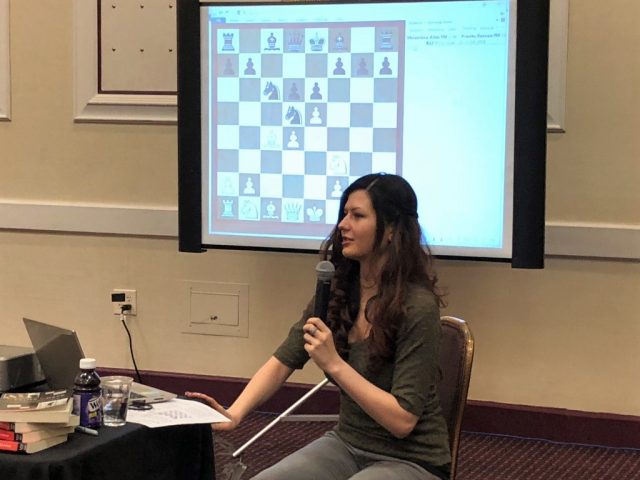 FM Alisa Melekhina covers key games on her way to finishing second in the U2300 of the 2017 NAO Open. She also gave a presentation on her recent book, Reality Check. Also featured is an interview with tournament winner GM Robert Hess. Alisa finishes her recap with her Top 3 Tips for Playing in a Tournament after a Long Break. The end of December is defined by the cheer of the holiday season and vacation getaways to warm destinations. For us tournament chess players, we have another enticing option: the annual North American Chess Open organized by the Continental Chess Association. As with previous years, the 27th annual edition of the event was held in fabulous Las Vegas during the week between Christmas and New Year’s from December 26-30, 2017. The timing of the tournament made it a convenient option for students on break and non-chess professionals enjoying the slowness of the holiday season. Now that my vacation days are circumscribed by my work schedule, I have to select my tournaments carefully. I knew the tournament would be a gamble, so to speak, as my last major event was the U.S. Women’s Championships in 2016. Ultimately, there were enough factors weighing in favor of playing at the NAO: timing, location, venue, prize potential, and a 7-round vs. 9-round option. Viva Las Vegas
FM Alisa Melekhina covers key games on her way to finishing second in the U2300 of the 2017 NAO Open. She also gave a presentation on her recent book, Reality Check. Also featured is an interview with tournament winner GM Robert Hess. Alisa finishes her recap with her Top 3 Tips for Playing in a Tournament after a Long Break. The end of December is defined by the cheer of the holiday season and vacation getaways to warm destinations. For us tournament chess players, we have another enticing option: the annual North American Chess Open organized by the Continental Chess Association. As with previous years, the 27th annual edition of the event was held in fabulous Las Vegas during the week between Christmas and New Year’s from December 26-30, 2017. The timing of the tournament made it a convenient option for students on break and non-chess professionals enjoying the slowness of the holiday season. Now that my vacation days are circumscribed by my work schedule, I have to select my tournaments carefully. I knew the tournament would be a gamble, so to speak, as my last major event was the U.S. Women’s Championships in 2016. Ultimately, there were enough factors weighing in favor of playing at the NAO: timing, location, venue, prize potential, and a 7-round vs. 9-round option. Viva Las Vegas
 While Bally’s is one of the more modest options on the Strip, it’s proximity to the luxurious Bellagio and Caesar’s Palace hotels across the street provide a full Vegas experience at a more reasonable price. The chess hotel rate was $99-$109/night.
While Bally’s is one of the more modest options on the Strip, it’s proximity to the luxurious Bellagio and Caesar’s Palace hotels across the street provide a full Vegas experience at a more reasonable price. The chess hotel rate was $99-$109/night. Catching up with IM Nazi Paikidze, now a Las Vegas local, and WFM Maria Manelidou at the Mandarin Oriental.
Catching up with IM Nazi Paikidze, now a Las Vegas local, and WFM Maria Manelidou at the Mandarin Oriental.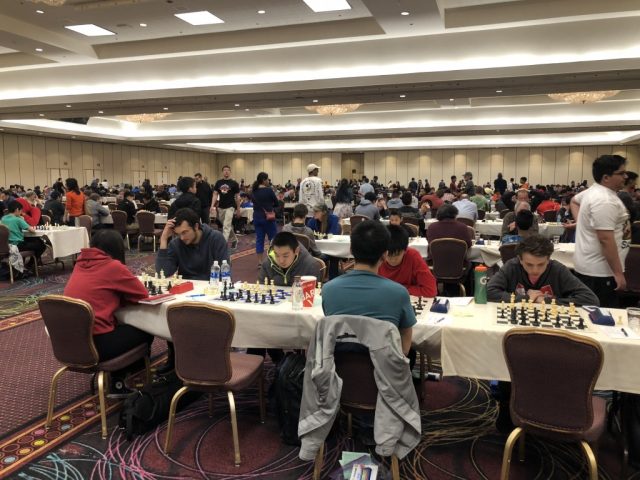 The convenience of a venue should not be underestimated during a chess tournament, especially when the rounds are grouped together in an accelerated double-round/day schedule. The tournament hall was in the same tower as most of the guest rooms. Although it was a quick elevator-ride away, the elevators would get full close to the start of the round and the dismayed procrastinators would have to wait for the next opening. Photo Juan Jauregui
The convenience of a venue should not be underestimated during a chess tournament, especially when the rounds are grouped together in an accelerated double-round/day schedule. The tournament hall was in the same tower as most of the guest rooms. Although it was a quick elevator-ride away, the elevators would get full close to the start of the round and the dismayed procrastinators would have to wait for the next opening. Photo Juan Jauregui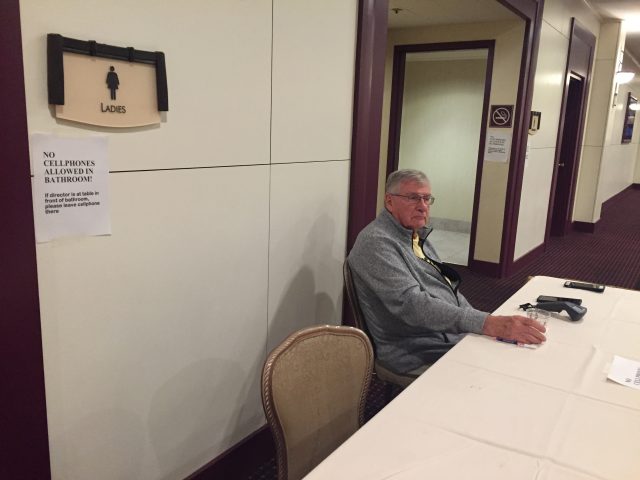 As an added anti-cheating measure, players using the restroom during the rounds are screened for electronic devices.
As an added anti-cheating measure, players using the restroom during the rounds are screened for electronic devices.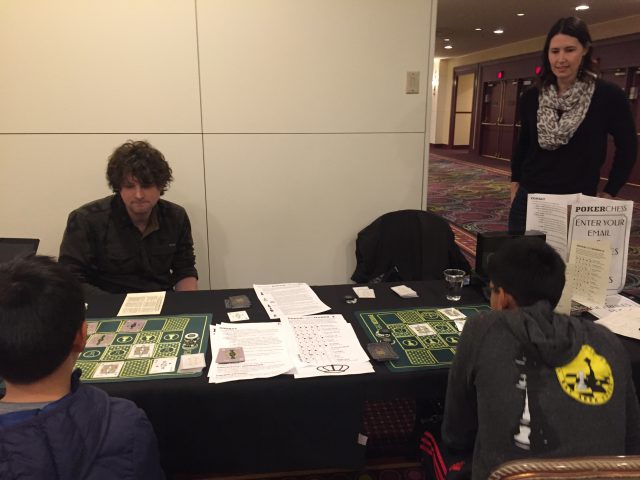 It is not unusual to see chess vendors around tournament halls. This year, a new board game called Poker Chess (PokerChess.com) set up shop outside. Challengers used the hybrid chess/poker game deck and board to try to win a free set.
It is not unusual to see chess vendors around tournament halls. This year, a new board game called Poker Chess (PokerChess.com) set up shop outside. Challengers used the hybrid chess/poker game deck and board to try to win a free set.With $120,000 in total guaranteed prizes, the prize fund was among the higher of the larger-stakes events hosted by the CCA. However, what differentiated this tournament for me was the availability of an U2300 section. Usually, the next class section after the Open is U2200. This places players at the master level in somewhat of a dilemma. We are used to being jostled around in the open section, stuck in the high-variance loop of playing up/down. For example, in a warm-up event at the Marshall Chess Club a week before the NAO, I went from playing a 1600 in round 1, to a 2500 the next round. For those of us at the tail-end of the Open section, a Swiss tournament can be a tumultuous experience with a scramble for one-off top class prizes. In contrast, the juicy first prize of $7,000 in the NAO U2300 was an incentive that was well within reach. And it’s never about the money. Chess players are trained to thrive in competition; goals that are both meaningful and feasible are essential components. Open sections offer tremendous experience to players looking to improve, and I highly encourage those looking to raise their game to seek out greater challenges. But, sometimes it is desirable to play in a tournament for the experience or the aesthetics of the game. In these circumstances, I prefer a consistent playing field to one of high-variance. As I discuss in my book, it is important to define goals and expectations before pursuing victory. Playing chess does not necessarily mean that your goal has to be to become the world champion; there are alternatives to meaningfully integrate chess in our lives. Coming in to the U2300 sction as one of the favorites was also a much-needed confidence boost after not playing seriously for a while. Psychological impact on chess should never be underestimated; it’s possible that the expectation of winning accounted for rising to the occasion. I went undefeated in the tournament and went into the last-round tied for first. I ended with 5.5/7 and split second for a nice payout of $1,516.17. It’s a Woman’s World A conspicuous feature of the final round was that the top three boards in the U2300 section each had a female player as the frontrunner. WIM Megan Lee won on board one to clinch clear first. On the other side of me on board 3, WFM Thalia Cervantes defeated the section’s top seed, Garoush Manukyan (2295) to join the tie for second. The 15-year-old had a breakout event, gaining over 60 USCF rating points and surpassing the 2200 benchmark. Originally from Cuba, Cervantes now lives in St. Louis to focus on chess. The women in this section were not to be underestimated. The only games where I came close to losing in the tournament were against Lee and Cervantes.
The Open section was not without its share of enterprising female players such as young stars WIM Annie Wang, FM Akshita Gorti, WIM Emily Nguyen and WCM Rochelle Wu. While I don’t have the data on trends in the number of participating female players over the years, there was a different feel to this tournament.
Growing up playing in open Swisses for the last two decades, I would be among the few female players in the entire tournament. Now, among the record turn-out of 805 participants, there were young women not only competing at all levels, but often being the front runners. Their presence was palpable. Perhaps it was the timing of the event in attracting young players during their winter break, or the subtle incentive embedded in the bonus mixed doubles prize — a not insignificant $2,000 for first. Or maybe it’s a new era in U.S. chess. GM Robert Hess, commenting in his capacity as the coach of the U.S. Women’s Olympiad and World Cadet teams, suggested that the rise could be due to, “more role models and more incentives, such as the Girls’ Junior Championships.” Morning Dose of Reality Check In keeping with a strong female representation at open events, I was delighted to be the guest lecturer of the tournament. CCA tournaments usually feature GM/IM lectures or game analysis. With thanks to the tournament organizer, Bill Goichberg, the lectures are free for tournament players. The “catch” is that the lectures usually begin early at 9:00 A.M. before a scheduled 11:00 A.M. morning round (scheduling a lecture post-round would not be feasible given unpredictable end-times for the games). I was concerned that the timing may affect turn-out. Waking up before 9:00 A.M. on the third day of a grueling tournament is tough enough, even tougher in Las Vegas! On the day-of, I was pleased to see around 50 attendees. Special thanks are due to Juan and Sabrina Jauregui, founders of the burgeoning Las Vegas Chess Center, for helping with on-site tournament registration and for supporting the lecture & book signing.
My lecture focused on the themes of decision-making and logical thinking prevalent in my new release this year, Reality Check: What the Ancient Game of Chess Can Teach You About Success in Modern Competitive Settings. My hope for the audience was that they would take away a more rigorous approach to their decision-making over the board. I opened with a few examples of tactics to distinguish between calculation and decision-making, and then progressed to a more advanced example of inflection points for decision-making in real chess games.
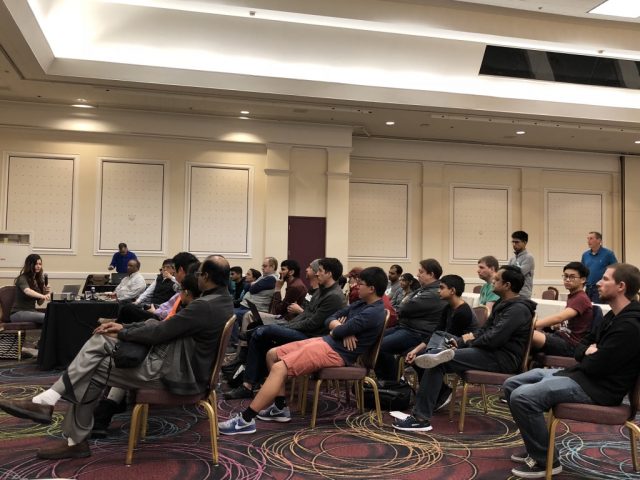 The attendees were from various sections and included kids, adult players, and parents. Photo Juan Jauregui
The attendees were from various sections and included kids, adult players, and parents. Photo Juan Jauregui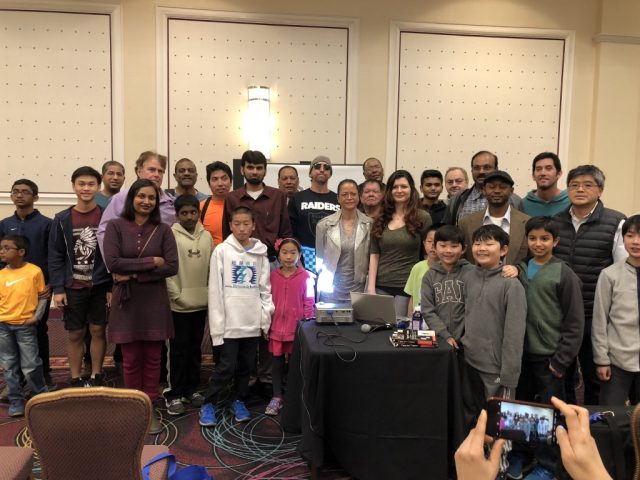 Partial group photo of the early-risers. More than a few people told me, after the morning round that day, that they won using the tactics and lines we discussed! Photo Juan Jauregui
Partial group photo of the early-risers. More than a few people told me, after the morning round that day, that they won using the tactics and lines we discussed! Photo Juan Jauregui The main example was from my favorite opening, the c3 Sicilian for white. I previously made a YouTube video for iChess on How to Win in the c3 Sicilian in 21 moves or Less—the title was inspired by miniatures won in this line. I supplemented with an article on Alapin theory in the October 2014 issue of Chess Life. At the end of my lecture, I joked that I was happy that my first-round opponent at the NAO didn’t see this content because the game was from this exact line. It just exceeded 21 moves, but nevertheless served as the perfect start to my tournament.
[pgn] [Event "NA Open U 2300"] [Site "?"] [Date "2017.12.26"] [White "Melekhina, Alisa"] [Black "Stein, Jeremy"] [Result "1-0"] [ECO "B22"] [WhiteElo "2270"] [BlackElo "2118"] [PlyCount "47"] [EventDate "2015.??.??"] [SourceDate "2003.09.03"] 1. e4 c5 2. c3 Nf6 3. e5 Nd5 4. Nf3 Nc6 5. d4 cxd4 6. cxd4 d6 7. Bc4 e6 8. O-O dxe5 9. dxe5 Be7 10. Qe2 O-O 11. Nc3 Nxc3 12. bxc3 Qc7 13. Qe4 b6 14. Bg5 Bb7 15. Bd3 g6 16. Bf6 Bxf6 17. exf6 Rfd8 {Black usually wins in this line in one of two ways. If he manages to liquidate into an endgame, he will most likely be able to take advantage of white's loose pawn structure. Second, black may be able to provoke white into over-extending by making a premature sacrifice. Developing moves like Rfd8 are generally consistent with these options, but are too slow when White already has an attack brewing.} (17... Nb8 $1 {is completely counterintuitive, but does the trick in re-arranging the knight to a better defensive post, as well as uncovering the b7 bishop.} 18. Qh4 Nd7 $15 {This blocks the strong Ng5 because the f6 pawn will be hanging.} 19. Ng5 Nxf6) 18. Qh4 $1 Qd6 19. Rad1 Qf8 20. Ng5 $18 h6 {Diagram [#]} 21. Bxg6 $1 fxg6 ( 21... Rxd1 22. Bxf7+ Qxf7 23. Nxf7 Rxf1+ 24. Kxf1 Kxf7 25. Qxh6 {[%cal Gh6g7, Gg7b7] White has too many insurmountable threats -- such as checkmates and winning the Bishop on b7 with a pin -- notwithstanding the material imbalance.} ) 22. f7+ Kh8 23. Nxe6 g5 (23... Qxf7 24. Nxd8 Nxd8 25. Rxd8+ Rxd8 26. Qxd8+ Kg7 27. Re1 {[%cal Ge1e7] Again, white's control of the seventh rank proves insurmountable.}) 24. Qh5 {[%cal Gh5h6] Simple and maintaining the crushing position. Black has no moves.} 1-0[/pgn]
Endearing Endgames Logical chess sequences often occur in endgames because there are fewer overall pieces, allowing your pieces to coordinate. I had a few such “logical endgame” puzzles occur in my games. I remember thinking, while I was playing, that it’s too bad chess can’t be this logical in earlier stages of the game — these puzzles were a joy to figure out over the board. [pgn] [Event "NA Open U 2300"] [Site "?"] [Date "2017.12.27"] [White "Senthilkumar, Pranav"] [Black "Melekhina, Alisa"] [Result "0-1"] [ECO "A46"] [WhiteElo "2156"] [BlackElo "2270"] [SetUp "1"] [FEN "6k1/4pp1p/6p1/2R5/8/2P3P1/1rr2P1P/5RK1 w - - 0 31"] [PlyCount "24"] [EventDate "2015.??.??"] [SourceDate "2003.09.03"] 31. h4 h5 {Several moves ago, I chose to exchange my bishop for white's knight to force this situation. My rooks are doubled on the second rank, relegating white's rook to a defensive role. I can also force the win of the c3-pawn. Theoretically, even after I win that pawn, the endgame should be a draw since white correctly locked in the diagonal f2-g3-h4 pawn formation. However, I nevertheless strove for this position because I knew that it is highly unpleasant for white to patiently defend this game while it now has, practically, only two results (draw or black wins).} 32. Re1 $2 {This makes my job tremendously easier. White needs to accept his fate and hold the inferior endgame. This is not the right time for counterplay.} (32. Kg2 e6 33. c4 Kg7 34. Rc8 Kf6 35. c5 Rb5 36. c6 Rbc5 37. Ra1 Rxc6 38. Rxc6 Rxc6) 32... Rxf2 33. Re3 Rfc2 34. Rf3 {Diagram [#] How to make progress? This is where the logical sequence kicks in. I see an opportunity to switch the order of my rooks in order to free the "front" rook for a better role.} Rg2+ 35. Kf1 Rh2 36. Kg1 Rbg2+ 37. Kf1 Rc2 38. Kg1 {This was all forced because of the back-rank mate threats.} Rhe2 39. Kf1 Rh2 {This is one of those repetitions to meet sudden death...and lull white into a false sense of security.} 40. Kg1 Rhd2 41. Rc4 $2 {misses my plan all along.} Rd1+ 42. Rf1 Rd3 {and after the g3 pawn falls, so will the rest.} 0-1[/pgn]
[pgn] [Event "NA Open U 2300"] [Site "?"] [Date "2017.12.29"] [Round "6"] [White "Lee, Megan"] [Black "Melekhina, Alisa"] [Result "1/2-1/2"] [ECO "B39"] [WhiteElo "2270"] [BlackElo "2270"] [SetUp "1"] [FEN "8/8/3b1k2/6pp/1pK2P2/1P4P1/P1B4P/8 w - - 0 36"] [PlyCount "33"] [EventDate "2015.??.??"] [SourceDate "2003.09.03"] 36. h4 gxf4 37. gxf4 {Even though I am two whole pawns down, the opposite-colored bishops provide drawing chances so long as I adopt the correct placement. The b4 pawn is the crux of black's position, nullifying white's extra a2 pawn. White has a shot at winning if she is able to sacrifice the a-pawn and create two passed pawns: the b-pawn, and ideally the f-pawn given that the h-pawn is the wrong colored square.} Be7 38. Bb1 Bd6 39. Bd3 ( 39. a4 bxa3 40. b4 Bxf4 $11 {shows why hurrying with a4 does not work. I will be able to win the h4 pawn before white has a chance to promote, and can then sacrifice my bishop for a draw. White could try moving the pawn to f5 first, but will eventually have to relinquish it after I force matters with a2.}) 39... Be7 {I have to keep calm while white figures out a plan that at least gives me a chance to stumble.} 40. Kd5 Kf7 41. Be2 Kg6 42. Ke6 {White chose to sacrifice a pawn to remove my king from the f-file and try to sneak in a pawn promotion.} Bxh4 43. f5+ Kh6 {This is where I have to be careful. It may look scary to allow the pawn to get to f6, but it is far more important to keep the h-pawn. It indirectly stops white's winning shot of a4. White's bishop won't be able to stop both of the pawns and thus cannot afford to sacrifice the a-pawn.} 44. f6 Bf2 $1 {When playing Kh6, I had to calculate this sequence to ensure white is not queening. My king is close enough to keep up with the f-pawn, even if white considers sacrificing the bishop by taking on h5.} 45. Ke7 Bc5+ 46. Kf7 Bd4 {Another important moment. By attacking the pawn from behind, white cannot make progress. Interestingly, white could have tried 45. Kf7 immediately, when the correct move would also have been Bd4. I agree that throwing in Ke7 first is a nice practical try; it could inadvertently lull black into a false sense of security and overlook the necessary Bd4 the next move.} (46... h4 $4 47. Kg8 $1 h3 48. f7 Kg5 49. f8=Q Bxf8 50. Kxf8 h2 51. Bf3 Kf4 52. Bc6 Ke3 53. Ke7 Kd2 54. Kd6 Kc3 55. Kc5 $18) 47. Ke7 Bc5+ 48. Ke8 h4 ( 48... Bd4 $4 {would now be a mistake because white can keep pushing the pawn.} 49. f7) 49. f7 Kg7 50. Bg4 Bf8 51. Be6 Bc5 52. Kd7 {I am able to move my bishop back-and-forth to c5 and f8. White cannot make any progress. If white strays too far with the King, I can "exchange" the h-pawn for her f-pawn. Now, the b4 pawn would really lock in the position as creating a passed b-pawn for white would be futile without other targets on the board.} 1/2-1/2[/pgn]
Over in the Open section, a missed winning endgame sequence disrupted IM Kostya Kavutskiy’s almost-stellar finish. Going into the last round, he had 5/8 and was playing GM Mark Paragua on board 12. A win would have likely shared the $2,400 prize for top U2400. For many players, missing a last-round win against a GM would be devastating. However, always the good sport, Kavutskiy comments: “The game went surprisingly well, and I found myself an exchange up with a more-or-less easy winning path. Of course, I managed to mess it up, and having reached this position, I realized White's winning chances had finally evaporated, as Black's counterplay with h3+ (followed by a king move and Be5) is quite dangerous. So I played… [pgn] [Event "2017 North American Open"] [Site "Las Vegas, Nevada"] [Date "2017.12.30"] [Round "9"] [White "Kavutskiy, Kostya"] [Black "Paragua, Mark"] [Result "1/2-1/2"] [ECO "D85"] [WhiteElo "2369"] [BlackElo "2513"] [Annotator "Kostya"] [SetUp "1"] [FEN "5R2/4p3/PR3b2/5k2/7p/r7/6K1/8 w - - 0 60"] [PlyCount "5"] [EventDate "2017.??.??"] 60. Rb5+ {acquiescing to a draw after basically any king move.} Ke6 61. Rb6+ Kd7 $5 {This move struck me as odd, since Black could have just repeated the position with Kf5. I thought for about 30 seconds, mostly thinking about Black's threat of h3+, followed by Be5 and Ra1. Having resigned myself to a draw on the previous move, I played} 62. Rfxf6 {and offered a draw. Paragua breathed an extraordinary sigh of relief, gave me a funny look, shook my hand, and when I finally sensed something was up he then showed me the winning line:} (62. Rbxf6 $1 {This rook!} exf6 63. a7 $1 {Literally the oldest endgame trick in the book. In my daze, I completely missed an idea most of my students would see quickly.} Rxa7 64. Rf7+ $18 {and White would win...[AM note: It is unusual for an e7 pawn to persist until the endgame. Not that it makes accepting the turn of events any easier, but it is at least understandable why this tactic would be missed OTB.]}) ({For the record,} 62. Rb7+ $1 Kc6 63. Rc8+ Kd5 64. a7 h3+ 65. Kh1 {was also winning, as White is just in time to meet} Be5 {with} 66. a8=Q $18 {Oh well, an embarrassing finish in my final game of 2017, I guess that's life!}) 1/2-1/2[/pgn]
 Although there was no Christmas tree in the playing hall, IM Kavutskiy’s new hair color lit up the room. Photo Kostya Kavutskiy
Although there was no Christmas tree in the playing hall, IM Kavutskiy’s new hair color lit up the room. Photo Kostya Kavutskiy [C]Hess Goals GM Hess also credits an endgame en route to his victory in the open section. He won first place on tiebreaks with 7/9 and took home $4,140. His favorite game of the tournament was surprisingly not a win, but his 86-move, round-8 draw against GM Sam Sevian. Hess explains, “It was a hard-fought draw. Holding a very strong, talented GM to a draw made it my most meaningful game of the tournament. I was slightly worse, had less space, made some inaccuracies, and released the tension early. Although I was eventually able to neutralize, I had only 20 seconds left in the knight endgame. A memorable moment occurred at the very end when my knight was trapped. White didn’t have to recapture.”
[pgn][Event "27th North American Open"] [Site "Las Vegas USA"] [Date "2017.12.29"] [Round "8.1"] [White "Sevian, Samuel"] [Black "Hess, Robert"] [Result "1/2-1/2"] [ECO "C77"] [WhiteElo "2614"] [BlackElo "2568"] [Annotator "Alisa Melekhina"] [PlyCount "172"] [EventDate "2017.12.26"] [EventRounds "9"] [EventCountry "USA"] [SourceDate "2015.04.04"]1. e4 e5 2. Nf3 Nc6 3. Bb5 a6 4. Ba4 Nf6 5. d3 d6 6. c3 Be7 7. O-O O-O 8. Re1 b5 9. Bc2 Bb7 10. Nbd2 Re8 11. d4 Bf8 12. h3 g6 13. d5 Ne7 14. b3 c6 15. c4 Bg7 16. Bb2 Qb6 17. a4 cxd5 18. cxd5 Nh5 19. Nf1 Reb8 20. Ne3 Bc8 21. Ba3 Nf4 22. a5 Qc7 23. Qd2 Bd7 24. Qb4 Nc8 25. h4 Bh6 26. Rac1 Qd8 27. g3 Nh5 28. Bd3 Rb7 29. Rc2 Rc7 30. Rxc7 Qxc7 31. Nh2 Nf6 32. Bc1 Ne7 33. Bd2 Rc8 34. Nf3 Bf8 35. Ng2 Qb8 36. Bg5 Ng4 37. Nh2 h6 38. Nxg4 Bxg4 39. Bd2 Bf3 40. Be2 Bxe2 41. Rxe2 Kh7 42. Be3 Ng8 43. Ne1 Be7 44. Nd3 Qc7 45. Re1 Qd7 46. Qd2 Qh3 47. Rc1 Nf6 48. Rxc8 Qxc8 49. f3 Qh3 50. Qg2 Qc8 51. Qd2 Qh3 52. Qg2 Qc8 53. Nb4 Qc3 54. Qd2 Qxb3 55. Nxa6 Bd8 56. Bb6 Bxb6+ 57. axb6 Qxf3 58. Qf2 Qxf2+ 59. Kxf2 Nxe4+ 60. Ke3 Nf6 61. b7 Nd7 62. Nc7 b4 63. Ne8 Nb8 64. Nxd6 b3 65. Kd3 Kg7 66. Kc3 Kf6 67. Kxb3 Ke7 68. Nc4 f6 69. Kb4 Kd7 70. Kc5 Kc7 71. d6+ Kxb7 72. Kd5 Nd7 73. Ke6 Kc8 74. Kf7 g5 75. Kg6 gxh4 76. gxh4 e4 77. Kxh6 Ne5 78. Ne3 Kd7 79. Kg7 Kxd6 80. h5 Ke6 81. h6 Nf7 82. h7 Nh8 83. Kxh8 (83. Nc2 $1 {White would have to find the intricate manuever to Nd6 in order to win the game. Not an easy feat after a long game with limited time.} Ke7 84. Nd4 Nf7 (84... e3 85. Nf5+ Ke6 86. Nxe3) 85. Nf5+ Ke6 86. Nd6 $1 Nh8 87. Kxh8 Kxd6 88. Kg7) 83... Kf7 84. Nf5 Kf8 {Without black's extra pawns, this would be a textbook win because white would be able to force the king to the e-file. Unfortunately, if white displaces the knight to h6 or d6, black promotes.} 85. Ne3 (85. Nd6 e3 86. Nf5 e2) 85... Kf7 86. Nf5 Kf8 1/2-1/2[/pgn]
As in my case, Hess was re-entering the open tournament circuit after somewhat of a hiatus. His previous major event was the 2017 Winter Classic round-robin in St. Louis in March where he finished third with 5/9. When asked how round-robins compare to Swisses, he quipped “It’s like apples to spaghetti,” wanting to keep the analogy within the realm of food: Swisses require coping with two arduous games per day, but round-robins have the added pressure of thoroughly preparing for each opponent. Each format requires its own strategy. Hess feels that, “Opens help a non-theoretical style, such as myself, to catch people off guard. On balance, I prefer playing in Swisses.” Though, “I am definitely open to receiving invitations to strong, prestigious round-robins,” he (half)-joked. Hess credits his involvement in the chess community to staying sharp. Although he doesn’t play in open events as often as he used to, his commentary work, writing for Chess Life, and generally following top games keeps him in the loop. Now that Hess has private students, he has a new form of motivation: “My students have inspired me. I wanted to perform well because they look up to me.” I asked if having students look up to his performance would, on the flip side, add pressure. Hess rebuffed the idea: “No; I didn’t even think about not doing well.”
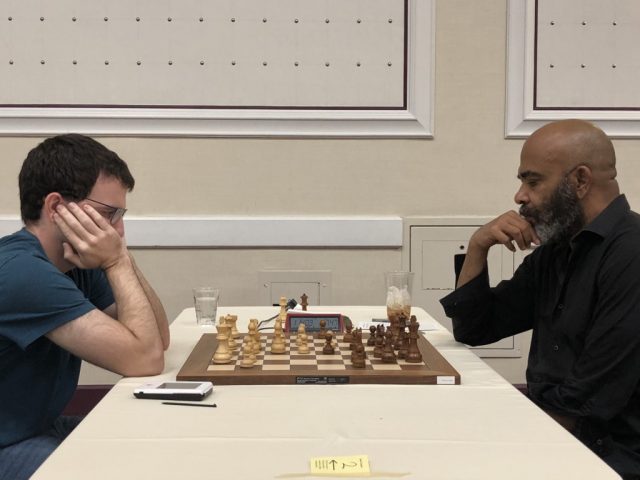 GM Hess facing off against IM Dionisio Aldama in round 5. The game ended in a draw and Aldama also finished with 7/9 to be the only IM to join the 5-way tie for first. Photo Juan Jauregui
GM Hess facing off against IM Dionisio Aldama in round 5. The game ended in a draw and Aldama also finished with 7/9 to be the only IM to join the 5-way tie for first. Photo Juan Jauregui Hess decided to play in the NAO because it coincided with a vacation in San Diego beforehand. Additional urging from long-time friend IM Teddy Coleman decided it. IM Coleman is one of many former junior players making a comeback. He “recently changed jobs for the excitement of working at a tech startup and [is] also working on chess on the side.” Coleman had a good start by drawing 16-year-old star and tournament favorite GM Ruifeng Li in round 3, but after one draw too many after that, ended the tournament with 5/9 and +10 rating points. As much as the tournament landscape has changed since I began competing nearly 20 years ago, there is a common thread that draws chess players back in. As I was looking through old chess photos to possibly include in the article, I was pleasantly surprised to come across an old Pan-American Youth team photo from 2001 in Argentina, including many familiar faces. 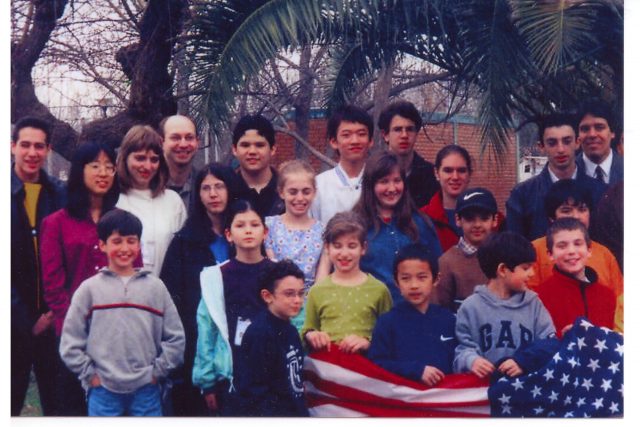 Pan-American Youth team photo. Argentina, 2001. Among the familiar faces are, from left to right, Teddy Coleman, myself, Fabiano Caruana, and Robert Hess on the end-right. Joel Benjamin and Tom Brownscombe were the team coaches. And there the three of us were, over 16 years later at the NAO, still engaged in a post-mortem analysis in a skittles room. (Not to mention that Tom Brownscombe, who came as one of the coaches for team USA that year, was also one of the NAO tournament directors this year.) What keeps us playing even when we have all had such divergent academic and career paths? In fact, the last time I interviewed Hess was for my Career Crossroads cover article in the April 2015 edition of Chess Life.
Pan-American Youth team photo. Argentina, 2001. Among the familiar faces are, from left to right, Teddy Coleman, myself, Fabiano Caruana, and Robert Hess on the end-right. Joel Benjamin and Tom Brownscombe were the team coaches. And there the three of us were, over 16 years later at the NAO, still engaged in a post-mortem analysis in a skittles room. (Not to mention that Tom Brownscombe, who came as one of the coaches for team USA that year, was also one of the NAO tournament directors this year.) What keeps us playing even when we have all had such divergent academic and career paths? In fact, the last time I interviewed Hess was for my Career Crossroads cover article in the April 2015 edition of Chess Life. 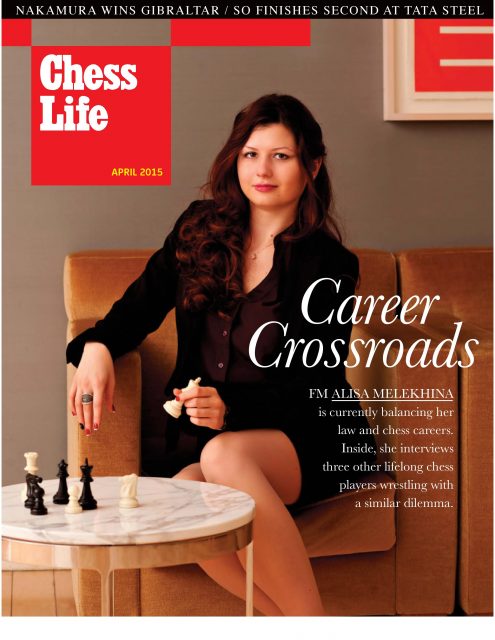 We had ultimately agreed that balancing “competitive” chess and other careers turns on what one means by “competitive.” Nowadays, the chess world offers so many alternatives to staying involved outside of simply becoming an elite player. When asked about long-term chess goals three years ago, Hess’ position was, “I don’t really like setting goals; I like being happy.” Now, even since graduating from Yale in 2015, not much has changed. “Chess is something I will always do,” citing to opportunities like commentary to stay involved. He noted that there is a difference between pursuing chess as a profession and as a career. Moreover, the flexibility of chess allows one to be involved in multiple pursuits without being limited to a single career. Top 3 Tips for Playing in a Tournament after a Long Break The sentiments are similar to what I advise those who ask me about the best way to study chess while maintaining full-time careers outside of chess. In fact, that is one of the most frequent questions I receive during Q&A of my book signings. Here are the top three tips I offer for those occasional tournament players who have other full-time commitments.
We had ultimately agreed that balancing “competitive” chess and other careers turns on what one means by “competitive.” Nowadays, the chess world offers so many alternatives to staying involved outside of simply becoming an elite player. When asked about long-term chess goals three years ago, Hess’ position was, “I don’t really like setting goals; I like being happy.” Now, even since graduating from Yale in 2015, not much has changed. “Chess is something I will always do,” citing to opportunities like commentary to stay involved. He noted that there is a difference between pursuing chess as a profession and as a career. Moreover, the flexibility of chess allows one to be involved in multiple pursuits without being limited to a single career. Top 3 Tips for Playing in a Tournament after a Long Break The sentiments are similar to what I advise those who ask me about the best way to study chess while maintaining full-time careers outside of chess. In fact, that is one of the most frequent questions I receive during Q&A of my book signings. Here are the top three tips I offer for those occasional tournament players who have other full-time commitments.
- Tactics, tactics, tactics. Tactics are by no means a cure-all for chess study. However, it is absolutely necessary to be warmed up with tactics before re-entering tournament play after a break. Preparation begins well before you actually play.
Blunders are one of the worst symptoms of rust. It doesn’t matter if you have strong understanding; your entire tournament could be marred by a blunder. Being limited in your tactical vision also causes indirect side-effects. Obscured board vision causes constant second-guessing. This in turn depletes time, which in turn causes notorious time-scrambles, which in turn leads to the usual “I was winning but lost in time trouble” narrative to lament over a tournament gone wrong. When I was competing regularly, I would rarely blunder. However, when playing after a break of several months, I noticed I would make uncharacteristic oversights. This would happen back in my law school days when my studies would overturn my chess priorities. After ruining a decent position to yet another blunder at the 2014 National Open in Las Vegas, I dropped out of the 6-round event. And I rarely drop out of tournaments. From that point on, I swore I would do at least 15 minutes of tactics a day. I am proud to say that I have, for the most part, kept up with that promise. I prefer the chess.com Tactics Trainer, but any tactics book or app, once a day, every day, will help keep you ready for when you decide to play. It’s simple but non-negotiable. As long as you’re a chess player, you must keep your tactical vision sharp.
- Play an OTB warm-up event. Players who are no longer active in tournaments may still be very active online. Yet, online games are not a substitute to playing over-the-board. There’s just something different about sitting down at a board, surveying the board in front of you, and physically moving the pieces. The experience of live play may feel foreign after a long break. To get fully back into chess mode, you need to reinstate the typical chess surroundings. Even if it’s at a different time control like a blitz event, make sure to squeeze in a live warm-up event within two weeks of your major event.
- Temper your expectations. Just because your live rating may reflect a certain level, say 2000, that doesn’t mean that you will necessarily perform at that level at your next tournament. Your rating reflects performance over a series of games over time. Your performance in any given tournament will not necessarily reflect your rating, especially if you’re out of practice. In that case, you may perform at the lower-end of your expected performance distribution.
Even if your rating indicates you are the favorite in the tournament, don’t expect to win. Instead, focus on other goals. Perhaps you want to play a good game in a new opening you have been studying or develop a greater appreciation for the aesthetic nature of the game. Tempering your expectations before going into a tournament will relieve the stress of playing after a break and help you enjoy the experience more. Then, you will be motivated to keep up with chess because you want to, rather than out of habit. FM Alisa Melekhina is a long-time competitor in US open tournaments and women’s national and world team invitational events. She graduated from the University of Pennsylvania Law school in May 2014 and is currently practicing as a corporate attorney in NYC. She previously wrote a popular CLO article on Balancing Law School and Chess. You can follow Alisa on facebook , twitter , and her personal chess website.
Categories
Archives
- January 2026 (2)
- December 2025 (27)
- November 2025 (29)
- October 2025 (39)
- September 2025 (27)
- August 2025 (29)
- July 2025 (43)
- June 2025 (25)
- May 2025 (24)
- April 2025 (29)
- March 2025 (29)
- February 2025 (20)
- January 2025 (24)
- December 2024 (34)
- November 2024 (18)
- October 2024 (35)
- September 2024 (23)
- August 2024 (27)
- July 2024 (44)
- June 2024 (27)
- May 2024 (31)
- April 2024 (51)
- March 2024 (34)
- February 2024 (25)
- January 2024 (26)
- December 2023 (29)
- November 2023 (26)
- October 2023 (37)
- September 2023 (27)
- August 2023 (37)
- July 2023 (47)
- June 2023 (33)
- May 2023 (37)
- April 2023 (45)
- March 2023 (37)
- February 2023 (28)
- January 2023 (31)
- December 2022 (23)
- November 2022 (32)
- October 2022 (31)
- September 2022 (19)
- August 2022 (39)
- July 2022 (32)
- June 2022 (35)
- May 2022 (21)
- April 2022 (31)
- March 2022 (33)
- February 2022 (21)
- January 2022 (27)
- December 2021 (36)
- November 2021 (34)
- October 2021 (25)
- September 2021 (25)
- August 2021 (41)
- July 2021 (36)
- June 2021 (29)
- May 2021 (29)
- April 2021 (31)
- March 2021 (33)
- February 2021 (28)
- January 2021 (29)
- December 2020 (38)
- November 2020 (40)
- October 2020 (41)
- September 2020 (35)
- August 2020 (38)
- July 2020 (36)
- June 2020 (46)
- May 2020 (42)
- April 2020 (37)
- March 2020 (60)
- February 2020 (38)
- January 2020 (45)
- December 2019 (34)
- November 2019 (35)
- October 2019 (42)
- September 2019 (45)
- August 2019 (56)
- July 2019 (44)
- June 2019 (35)
- May 2019 (40)
- April 2019 (48)
- March 2019 (61)
- February 2019 (39)
- January 2019 (30)
- December 2018 (29)
- November 2018 (51)
- October 2018 (45)
- September 2018 (29)
- August 2018 (49)
- July 2018 (35)
- June 2018 (31)
- May 2018 (39)
- April 2018 (31)
- March 2018 (26)
- February 2018 (33)
- January 2018 (30)
- December 2017 (26)
- November 2017 (24)
- October 2017 (30)
- September 2017 (30)
- August 2017 (31)
- July 2017 (28)
- June 2017 (32)
- May 2017 (26)
- April 2017 (37)
- March 2017 (28)
- February 2017 (30)
- January 2017 (27)
- December 2016 (29)
- November 2016 (24)
- October 2016 (32)
- September 2016 (31)
- August 2016 (27)
- July 2016 (24)
- June 2016 (26)
- May 2016 (19)
- April 2016 (30)
- March 2016 (36)
- February 2016 (28)
- January 2016 (32)
- December 2015 (26)
- November 2015 (23)
- October 2015 (16)
- September 2015 (28)
- August 2015 (28)
- July 2015 (6)
- June 2015 (1)
- May 2015 (2)
- April 2015 (1)
- February 2015 (3)
- January 2015 (1)
- December 2014 (1)
- July 2010 (1)
- October 1991 (1)
- August 1989 (1)
- January 1988 (1)
- December 1983 (1)



